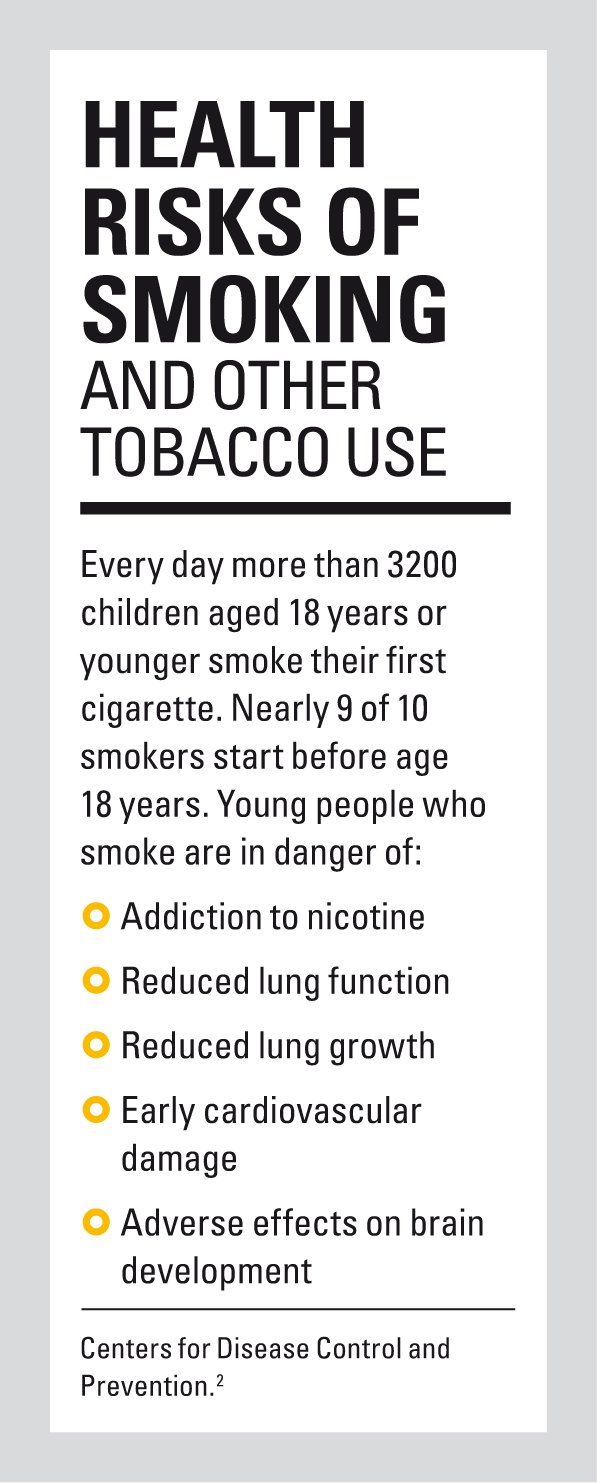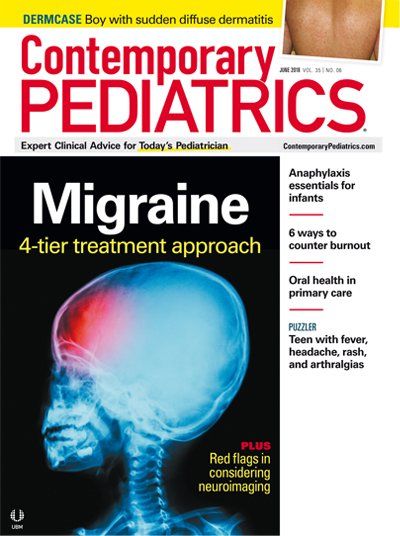JUULING: What kids don’t know will hurt them
Healthcare providers must communicate to their adolescent and young adult patients the dangers of electronic nicotine delivery systems.
Health risks of smoking

Nearly 4.7 million adolescents and young adults in the United States smoke traditional cigarettes.1 These statistics represent an all-time low in a population in which tobacco use primarily begins. Nine of 10 young persons have tried a cigarette by the time they turn 18 years of age.2 From 2011 to 2016, there has been a decline in traditional cigarette smoking, particularly among middle school and high school students.3 The continued concern is the progression of youth smoking into adult smoking attributed to the addicting characteristics of nicotine.
Two novel nicotine-laden products, called JUUL (pronounced “jewel”) and PHIX (pronounced “fix”)4 are on the market, and smoking these has become an epidemic in schools and colleges across the country. The JUUL (JUUL Labs Incorporated; San Francisco, California) and PHIX (PhixVapor, Brea, California) are not unlike the electronic cigarettes, or electronic nicotine delivery systems (ENDS), that adults are using in an attempt to quit smoking traditional cigarettes. However, JUUL and PHIX provide flavored products that lure young people.
These devices are similar in function to the ENDS that adolescents have been trialing, although there is not degradation to a zero-nicotine product. Another difference is that JUUL and PHIX do not have the appearance of a cigarette or typical vaping device, and they can be wrapped to customize them with designs.5 In fact, these products appear to replicate the appearance of an extended flash drive or stick and are popular among adolescents and young adults who like to customize.
These devices have a slender style, create an energy boost or calming experience, and provide flavorings.6 Additionally, they are sleek and compact, making them easy to conceal. Both devices are charged using a cord that attaches to a USB port. They require no maintenance to refill the liquid nicotine because they feature convenient disposable “pods” that connect directly to the nondisposable section of the device. All JUUL and PHIX pods contain liquid nicotine that is vaporized and inhaled.
Health concerns
The practice of juuling is raising significant health concerns given previous research on electronic vaping devices. Adolescents and young adults refer to vaping a JUUL as “juuling” or “ripping” versus the traditional vaping. Of serious concern is the high amount of nicotine delivery within 1 JUUL pod and even more in the PHIX devices.
The Truth Initiative research indicates that 25% of adolescents and young adults refer to the practice as juuling, and 37% are unsure if the device contained nicotine.7 Previous research on ENDS products indicate that most products have varying amounts of nicotine compared with what is advertised, with most having more of the addictive component.8
The US Surgeon General has concluded that e-cigarette aerosol is not harmless and can contain harmful and potentially harmful chemicals, including nicotine,9 which is damaging to the developing brain. Research is continual and ongoing on ENDS products. Although nicotine is not consistent across devices, it is clear that vaping or ripping is a risky behavior based solely on having nicotine. Each JUUL pod contains 0.7mL with 5% nicotine by weight, approximately equivalent to 1 pack of cigarettes or 200 puffs.10 PHIX pods contain 1.7 mL of nicotine, equivalent to the amount of nicotine in 2 packs of cigarettes.11 Research on ENDS products has revealed cancer-causing agents, respiratory irritants, heavy metals, and volatile organic compounds. Studies have found these agents in both the vaper’s (person who vapes) urine and saliva, as well as in the surrounding air.12-16
Action steps
The increasing prevalence and known harm to young persons through the use of these and other ENDS products have prompted action. The American Academy of Pediatrics (AAP), who previously championed the Child Nicotine Poison Prevention Act of 2015 because of child illness and deaths from the overingestion of liquid nicotine, has provided a fact sheet for healthcare providers and parents. The fact sheet underscores the greatest concern related to JUULs-addiction and the potential risk of becoming a traditional cigarette smoker.17
The US Food and Drug Administration (FDA) has taken enforcement steps against the underage selling of the products to young persons and has indicated it will be developing a comprehensive plan to curb adolescent and young adult uptake.18
The American Association for Cancer Research and the American Society of Clinical Oncology have a policy statement supporting regulation, discouraging youth-oriented marketing and sales, and prohibiting the promotion of flavors that appeal to the young.19
The JUUL company has revamped its website to focus on adult users20 and is making statements in an effort to curb the acquisition of its products by young persons through age verification, marketing to adults only, and collaborating with law enforcement and school systems.21 This is similar to what the tobacco companies’ websites do to curb tobacco smoking among teenagers, which has been found to do more harm than good.22 These websites require a click on a tab to enter the website, stating one verifies one’s age of least 21 years. On the PHIX website, there is no evident indication that the product is to help quit smoking.
What you can do
Almost half a million people die each year in the United States because of tobacco use through cigarettes, making it this nation’s greatest cause of preventable death, far deadlier than obesity, alcohol, or motor-vehicle accidents. Risky behaviors are defined as potential actions leading to harm, loss, or danger in relation to health or happiness, and the literature often points out that risky behaviors start in the early teenaged years.22,23 Risky behaviors in these young populations are especially concerning because nicotine exposure in undeveloped brains can lead to reduction in focus, attention, and impulse control, as well as potential cognition or mood disorders.24
Research on the health risks of ENDS products, and particularly novel products, is in progress, but it takes time for the findings to become published. When examining adolescents and college students, it is imperative that healthcare providers communicate to them that harmful components are being delivered through these products.
Here are 3 steps that healthcare providers can institute in their practice to inform patients and their families about the health risks associated with nicotine delivery devices:
1. Ask specific and detailed questions regarding social use of cigarettes, electronic cigarettes, vape or vaping, and JUULs or particular product names. Practitioners should stay current with the terminology for multiple device delivery of nicotine and current adolescent/young adult-focused products on the market, such as PHIX and JUUL.
2. Reveal the contents of ENDS with patients and let them know the concerns you have as a healthcare provider. Then, educate adolescents, young adults, and families regarding the specific delivery systems and the harmful effects of their chemicals on the body.
3. Post resources in the office and in the examining rooms, such as those provided by the AAP, and consider your practices statement regarding the use of these products.
References:
1. US Department of Health and Human Services, Office of Adolescent Health. Adolescents and tobacco: trends. Available at: https://www.hhs.gov/ash/oah/adolescent-development/substance-use/drugs/tobacco/trends/index.html. Reviewed September 23, 2016. Accessed May 10, 2018.
2. Centers for Disease Control and Prevention. Smoking and youth. Available at: https://www.cdc.gov/tobacco/data_statistics/sgr/50th-anniversary/pdfs/fs_smoking_youth_508.pdf. Accessed May 10, 2018.
3. Jamal A, Gentzke A, Hu SS, et al. Tobacco use among middle and high school students-United States, 2011-2016. MMWR Morb Mortal Wkly Rep. 2017;66(23):597-603.
4. PhixVapor. Get your PHIX: Satisfy your cravings with the healthier alternative. Available at: https://phixvapor.com/. Accessed May 10, 2018.
5. JUULWraps. The benefits of applying a JUUL Wrap. Available at: https://juulwraps.com/blogs/blog/the-benefits-of-applying-a-juul-wrap. Published October 9, 2017. Accessed May 10, 2018.
6. Kasierski A. 3 things you’ll notice about people who use JUULs. Study Breaks website. Available at: https://studybreaks.com/news-politics/juul/. Published April 14, 2018. Accessed May 10, 2018.
7. Koval R. Latest Monitoring the Future Survey reveals good and bad news underscoring need for education and regulation. Available at:
https://truthinitiative.org/sites/default/files/Latest-Monitoring-the-Future-Survey-Reveals-Good-and-Bad-News-Underscoring-Need-For-Education-and-Regulation.pdf. Accessed May 10, 2018.
8. Raymond BH, Collette-Merrill K, Harrison RG, Jarvis S, Rasmussen RJ. The nicotine content of a sample of e-cigarette liquid manufactured in the United States. J Addict Med. 2018;12(2):127-131.
9. Centers for Disease Control and Prevention. Preventing chronic disease. Perceptions of harm to children exposed to secondhand aerosol from electronic vapor products, Styles Survey, 2015. Available at: https://www.cdc.gov/pcd/issues/2017/16_0567.htm. Updated September 20, 2017. Accessed May 10, 2018.
10. Chaker AM. Schools and parents fight a ‘JUUL’ epidemic. Wall Street Journal. Online edition. Available at: http://online.wsj.com/public/resources/documents/print/WSJ_-A009-20180403.pdf. Published April 3, 2018. Accessed May 10, 2018.
11. PhixVapor. PHIX: FAQ. Available at: https://phixvapor.com/pages/faq. Accessed May 10, 2018.
12. Rubinstein ML, Delucchi K, Benowitz NL, Ramo DE. Adolescent exposure to toxic volatile organic chemicals from e-cigarettes. Pediatrics. 2018;141(4):1-9.
13. Tierney PA, Karpinski CD, Brown JE, Luo W, Pankow JF. Flavour chemicals in electronic cigarette fluids. Tob Control. 2016;25(e1):e10-e15.
14. Williams M, Bozhilov K, Ghai S, Talbot P. Elements including metals in the atomizer and aerosol of disposable electronic cigarettes and electronic hookahs. PLoS One. 2017;12(4):1-24:e0175430.
15. Schober W, Szendrei K, Matzen W, et al. Use of electronic cigarettes (e-cigarettes) impairs indoor air quality and increases FeNO levels of e-cigarette consumers. Int J Hyg Environ Health. 2014;217(6):628-637.
16. Ichitsubo H, Kotaki M. Indoor air quality (IAQ) evaluation of a novel tobacco vapor (NTV) product. Regul Toxicol Pharmacol. 2018;92:278-294.
17. American Academy of Pediatrics, Section on Tobacco Control. JUULing: What pediatricians and families need to know. Available at: https://www.aap.org/en-us/Documents/AAP-JUUL-Factsheet.pdf. Accessed May 10, 2018.
18. US. Food and Drug Administration. Statement from FDA Commissioner Scott Gottlieb, MD, on new enforcement actions and a Youth Tobacco Prevention Plan to stop youth use of, and access to, JUUL and other e-cigarettes [press release]. Available at: https://www.fda.gov/NewsEvents/Newsroom/PressAnnouncements/ucm605432.htm. Published April 24, 2018. Accessed May 10, 2018.
19. Brandon TH, Goniewicz ML, Hanna NH, et al. Electronic nicotine delivery systems: a policy statement from the American Association for Cancer Research and the American Society of Clinical Oncology. J Clin Oncol. 2015;33(8):952-963.
20. JUUL Labs. For smokers. By design. Available at: https://www.juul.com/. Accessed May 10, 2018.
21. JUUL Labs. Youth education, awareness, and prevention. Available at: https://www.juul.com/youth-education-awareness-and-prevention. Accessed May 10, 2018.
22. Landman A, Ling PM, Glantz SA. Tobacco industry youth smoking prevention programs: protecting the industry and hurting tobacco control. Am J Public Health. 2002;92(6):917-930.
23. Childs KK, Ray JV. Race differences in patterns of risky behavior and associated risk factors in adolescence. Int J Offender Ther Comp Criminol. 2017;61(7):773-794.
24. Bell CC, McBride DF. Affect regulation and prevention of risky behaviors. JAMA. 2010;304(5):565-566.
